Can you imagine the frustration of constantly suppressing who you are? Can you picture living in permanent fear and uncertainty because of something as pure as love? Or even worse, can you imagine not even knowing it is possible to love at all?
Whilst discussing Eastern European media, with a focus on Romanian productions (due to personal extended contact with the culture), one can easily notice that even though homophobia is a transnational phenomenon, it manifests itself rather uniquely in the Romanian media. Although there is no secret that same-sex couples are not welcome anywhere in the Balkanic culture, it feels like the topic is so taboo that one would rarely hear hate speech loudly affirmed on Romanian grounds. Instead, if you listen closely, you can hear whispers of the forbidden sins and the catastrophes such things bring upon the good religious folks.
It’s not the rejection that posed the biggest problem, but rather the loud silence
To exemplify what I mean, here’s a historical fact: when Romania was practically forced into decriminalizing homosexuality in the late 1990’s - early 2000’s by European Authorities, activists, and human rights organizations, many political and clerical figures stepped forward. They confidently stated that prior to the western democracies invading the sacred space of our culture, sexual minorities did not exist in Romania, as it was a lifestyle fabricated by the capitalist society. Years of abuse were erased as if nothing ever happened.

However, not having to hide from the law anymore did not mean the instant beginning of a new era. The belief that queer love was unnatural and filthy was still standing strong. The fear of addressing the issue has been clearly reflected in the LGBTQ+ media productions created in the 2000s. Or rather in the lack of them.
Why media matters
In Marta Dyczok’s book Media, democracy and freedom: The post-communist experience, she states that “There is an undeniable role that the media has played in the socio-political transformations that have occurred in eastern-European countries in the post-communist era in transitioning to a more liberal mindset and general situation.” That is why we can see a country’s development through its media productions, and there is an undeniable urgency for more representation of sensitive topics on the big screen.
Romanian queer film
Focusing on the media landscape in Romania, few LGBTQ+ inclusive productions have been created since homosexuality was completely decriminalized in 2002. The situation is particularly vexing, considering the “sexually liberating” era of the film that began after the fall of the communist party. During that time in which there was no more harsh censorship, the cinematic world was finally allowed to explore new and exciting topics. The infinite freedom of feeding the public’s desire to normalize the physical romance, that was forbidden from the screens for so long, was unleashed.

The first movie that touched on the topic of LGBTQ+ was “Lovesick”, and it was only released in 2006, telling the story of two girls who meet at university and fall in love in a time of personal confusion. Quite a number of well-known figures that later expressed strong opinions against the LGBTQ+ community starred in secondary roles or made grand appearances at its premiere. This fact only suggests (as it is later also mentioned in the short queer production „Ana Is Coming Back”), that the woman-loving-woman story was easily fetishized by the public – a public that was still heavily repulsed by same-sex love, and could not view a male relationship in the same way.

As proof of this idea, we can direct our gaze to the 2017 movie “Soldiers. Story from Ferentari”, a screening that is controversial, not only through its portrayal of a love story between two men but also through its ethnic diversity. When this movie was projected in one of the museums in Bucharest, it attracted protests that interrupted the event and called for the intervention of police forces. In justifying their actions, the conservatives answered that they felt bound to protect the autochthonous values of the traditional Romanian society from the glorification of (homosexual) sins.
So, what now?
As the next years of cinematography went by, barely any other titles of the LGBTQ+ productions reached the screen of the cinemas, from the already few productions that dared to be released. Looking at the situation, my purpose in this article was to raise awareness about the issues present, and hopefully bring a spark of motivation for those who are striving to work in media production not to avoid controversial topics in their work, as the world needs to hear them, and there will be no change unless we make it ourselves!

